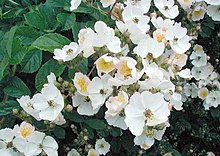Rosa multiflora
| Rosa multiflora | |
|---|---|
 |
|
| Scientific classification | |
| Kingdom: | Plantae |
| (unranked): | Angiosperms |
| (unranked): | Eudicots |
| (unranked): | Rosids |
| Order: | Rosales |
| Family: | Rosaceae |
| Genus: | Rosa |
| Species: | R. multiflora |
| Binomial name | |
|
Rosa multiflora Thunb. |
|
| Synonyms | |
|
|
Rosa multiflora, commonly known by its synonym Rosa polyantha and as multiflora rose,baby rose,Japanese rose,many-flowered rose,seven-sisters rose,Eijitsu rose, is a species of rose native to eastern Asia, in China, Japan and Korea. It should not be confused with Rosa rugosa, which is also known as "Japanese rose", or with polyantha roses which are garden cultivars derived from hybrids of R. multiflora.
It is a scrambling shrub climbing over other plants to a height of 3–5 m, with stout stems with recurved prickles (sometimes absent). The leaves are 5–10 cm long, compound, with 5–9 leaflets and feathered stipules. The flowers are produced in large corymbs, each flower small, 1.5–4 cm diameter, white or pink, borne in early summer. The hips are reddish to purple, 6–8 mm diameter.
Two varieties are accepted by the Flora of China:
Rosa multiflora is grown as an ornamental plant, and also used as a for grafted ornamental rose cultivars.
In eastern North America, Rosa multiflora is now generally considered an invasive species, though it was originally introduced from Asia as a soil conservation measure, as a natural hedge to border grazing land, and to attract wildlife. It is readily distinguished from American native roses by its large inflorescences, which bear multiple flowers and hips, often more than a dozen, while the American species bear only one or a few on a branch.
...
Wikipedia
